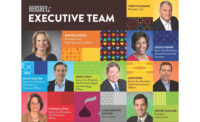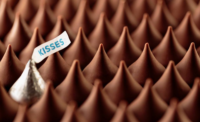![]()
Hershey Geared for Growth
Making confections more convenient and healthful and venturing
outside its candy comfort zone into the snack segment figure prominently in
Hershey’s strategic plans for 2004 and beyond.
By Mary Ellen Kuhn
Hershey, Pa. – Marketers here in the
nation’s chocolate capital have some pretty healthy growth
aspirations. Or one might say that they have aspirations for healthful
products growth.
Both statements are accurate.
Hershey’s 1 Gram Sugar Carb bar — targeted
to the fast-growing ranks of the carb-conscious — will make its
retail debut in March. It is the first launch from Hershey’s newly
formed Snacks Division, and company marketers see the carbohydrate-reduced
bar as a product with considerably more than mere niche-market sales
potential thanks to the estimated 10 million to 40 million Americans
currently pursuing carb-reduced diets.
“We think this is going to be an important
entry for us,” Andrew England, Hershey’s recently appointed
vice president and general manager of the Snacks Division, told Confectioner last month
during an interview on a frosty day in Hershey.
But the single-digit temperatures outside did nothing
to diminish the energy radiated by England and Chief Marketing Officer
Thomas Hernquist as they spoke of Hershey’s plans to leverage its
core strengths into new confectionery and snack products.
Shortly after that interview, the company announced that it
would venture into the nutritional bars segment with a rollout in the third
quarter based on the Zone Diet nutritional program. (See page 15 for additional
information.)
New division
Hershey’s move to form a Snacks Division in the
fourth quarter of 2003 should have come as no surprise to company watchers.
When Hershey Chairman, President and CEO Rick Lenny came on board in 2001
after three years as president of Nabisco Biscuits Co., he was quick to
suggest that the candy maker would explore opportunities in the $50 billion
U.S. snack market.
Lenny’s desire that Hershey move boldly into new
market segments has not diminished. “We have a clear message from
Rick that he would like to expand our portfolio quickly and boldly,”
said England.
In the past year, Hershey has been working hard (and successfully)
to position itself for profitable growth by selling off non-core brands, rationalizing
SKUs, and leveraging its core brands with new products and limited edition line
extensions such as Reese’s white chocolate peanut butter cups.
Action plan
Hernquist laid out Hershey’s strategic focus in
this way. “We’ve seen some real positive top-line momentum and
share growth,” he said. “And going forward, we’re going
to accelerate our top-line growth. Domestically, there are two primary
areas where we’ll accelerate top-line growth. The first is our core
confection business. The second is to pursue new ventures in adjacent snack
markets.”
Hershey’s 1 Gram Sugar Carb Bar takes the
company into a new section of the store — the nutritional products
aisle. “We will most likely get placement in both the confections and
nutrition bar sections, but our focus will be on the nutrition
aisle,” England stressed. “Our research shows that if
you’re looking at people who are shopping for low-carb products,
they’re not shopping the candy aisle,” he said.
“They’re shopping the nutrition aisle.”
“We think nutrition is an area where we can be
extremely successful,” England continued. “If you look at the
nutrition aisle in general, about two-thirds of the flavors are candy
flavors. The No.1 flavor is chocolate.”
And who better to go after chocolate lovers than
Hershey, he reflected. The success of Hershey’s sugar-free candy
line, unveiled last year, has demonstrated the company’s ability to
successfully court the health-conscious crowd.
“The performance of those products exceeded our
expectations,” said Hernquist. “Four of the top five sugar-free
SKUs, according to IRI [Information Resources Inc.], are
Hershey’s.”
Neither England nor Hernquist would reveal what’s up next
from the Snacks Division or name the “adjacent snack markets” into
which the company is headed. Hernquist said only that, “We’re evaluating
a number of different categories.”
Keeping it convenient
Meanwhile, Hershey will remain focused on delivering convenient
confectionery options.
“There’s a tremendous need and demand for
more convenient products in the marketplace,” said Hernquist.
“Today, consumers have less and less time, they’re eating on
the run, and there’s a lot of growth in the channels of distribution
that provide products for convenience-minded shoppers.
“Going forward, focusing on convenience —
via packaging and new product forms — will be a key thrust for
us,” he said.
Hernquist cited the example of Swoops — curved chocolate
slices packaged in single-serving plastic cups that come three per canister
— and Ice Breakers Liquid Ice — round, liquid-filled mouth fresheners
in a purse- or pocket-friendly package — as examples of the kinds of fun
and easily portable products Hershey will continue to offer.
Expanding Hershey’s horizons
Is America’s candy category leader shooting for
snack sector prominence as well as confectionery dominance? Definitely,
Hernquist and England agreed.
“Hershey has a rich history of producing and
marketing great tasting products,” said Hernquist. “The Hershey
and Reese’s brands have outstanding appeal and a deep emotional
connection with consumers. We have the opportunity to take those brands,
our heritage, and our history, and our ability to make and distribute great
tasting products to branch into other categories of business.
“Our products are available in over two million
points of distribution,” Hernquist continued. “We like to say
that we have ubiquitous distribution. So if you’re looking for a
snack, Hershey products are there.”
Added England, “Ten years from now, we want to be just
as well known for snacks [as for candy].”




